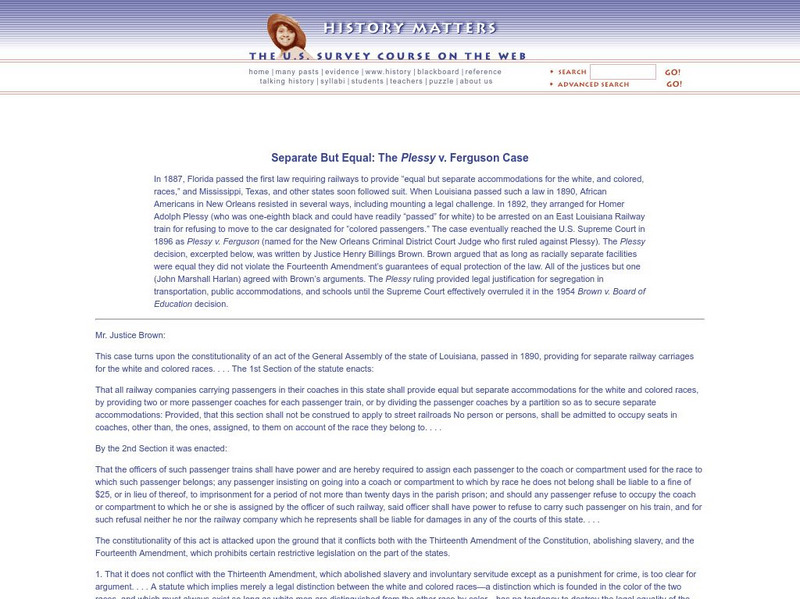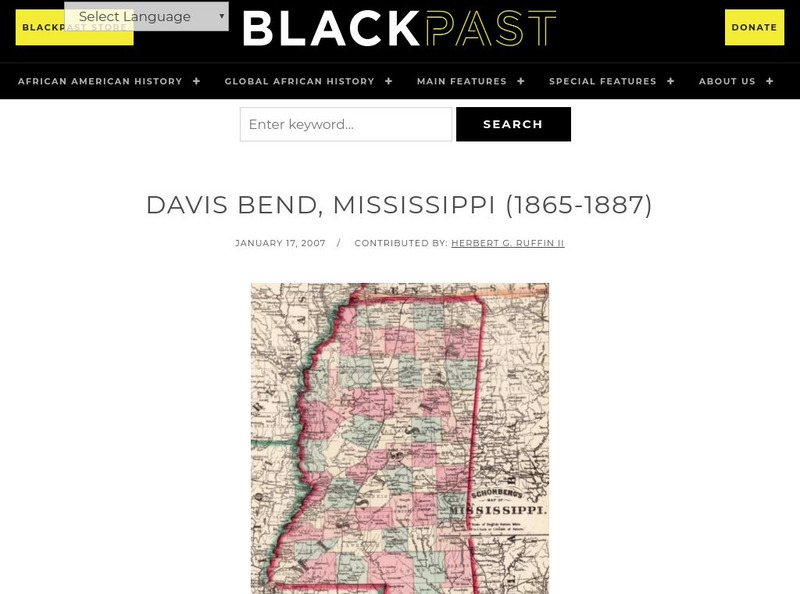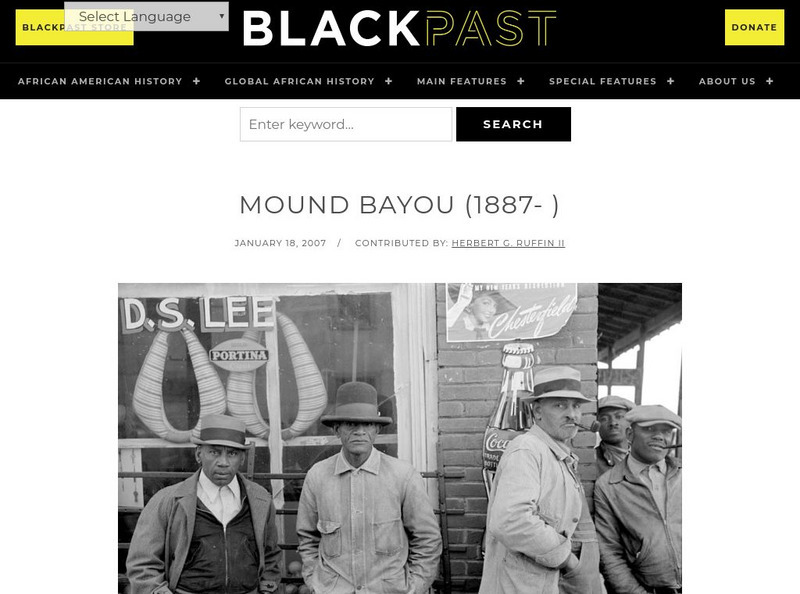Curated OER
History Matters: Separate but Equal: The Plessy v. Ferguson Case
Read the judgment of Supreme Court justice, Henry Billings Brown, who wrote for the majority in the Plessy v Ferguson decision that codified the idea of "separate but equal" in the American justice system until it was overturned by Brown...
American Public Media
Say It Plain: Speech to Atlanta Cotton States and International Exposition
Booker T. Washington made a consequential speech in Atlanta in 1895, known now as the Atlanta Compromise. Read about the speech, the consessions Washington felt African-Americans needed to make, and the context in which the speech was...
National Humanities Center
National Humanities Center: Toolbox Library: African American Identity: Volume Iii, 1917 1968: Segregation
Series of nine primary resources on African American identity explores the concept of segregation and how it was experienced through the years 1917-1968. Inlcudes discussion questions, notes and links to supplemental resources.
National Humanities Center
National Humanities Center: Teacher Serve: Segregation
Steven Lawson, Professor of History at Rutgers, explores how racial segreagation changed from before the Civil War up to the 1950s and the differences in segregation between the North and the South. Students should understand the legacy...
University of Missouri
Exploring Constitutional Conflicts: Plessy v Ferguson
Read the Supreme Court opinion that solidified the concept of separate, but equal in American law. The dissenting opinion written by Justice John Harlan is also included.
History Tools
Historical Sources Online: Booker T. Washington's "Atlanta Compromise" [Pdf]
Read the text of the speech delivered in Atlanta by Booker T. Washington on September 18, 1895, in which he attempted to reassure the mostly white audience that African Americans were looking for economic opportunities, not civil rights....
PBS
Wnet: Thirteen: The Rise and Fall of Jim Crow: The Atlanta Compromise Speech (1895)
Find out how Booker T. Washington tried to allay the fears of white Southerners in his speech in Atlanta in September, 1895. Although hailed as a new era in which blacks would give up their civil and political rights and in return get...
Ohio State University
E History: Lynching in America
Ohio State University gives a general discussion of lynching with links to numerous newspaper accounts of an 1897 lynching in Urbana, Ohio.
Other
Jim Crow Museum of Racist Memorabilia: What Was Jim Crow?
A listing of the Jim Crow laws and understood Jim Crow etiquette found across the South in the late 19th century.
Smithsonian Institution
National Museum of American History: Separate Is Not Equal: The Quest for Education
Part of a larger piece on Segregated America, this section focus is on the commitment and perseverance of African Americans in the post-Civil War South to overcome the obstacles standing in the way of an education. Offers teachers and...
National Humanities Center
National Humanities Center: Toolbox Library: Charles W. Chesnutt, Making of African American Identity: V. 2
A short story that explores the influence of the Southern plantation past on African American efforts to create new urban identities and the predicaments of post-emancipation life.
National Humanities Center
National Humanities Center: Toolbox Library: Racial Politics, Making of African American Identity: V. 2
Chapter from a novel and images that illustrate black political action in late-nineteenth-century America. Frances Harper's 1892 novel Iola Leroy, is examined, covering topics of white supremacy and racial justice.
National Humanities Center
National Humanities Center: Toolbox Library: Race Problem, Making of African American Identity: V. 2
A poem, an address, and a painting that illustrate black political struggle in late-nineteenth-century America. This series of resources characterize "the Negro Problem" as "a concrete test of the underlying principles of the great...
National Humanities Center
National Humanities Center: Toolbox Library: The Vote, Making of African American Identity: V. 2
An appeal for black voting rights and an editorial cartoon opposing them. This resource explains that while the 15th Amendment granted black men the right to vote, southern states fought to block its implementation.
National Humanities Center
National Humanities Center: Toolbox Library: African Americans, the Gilded and the Gritty: 1870 1912
A speech by Mary Church Terrell, a letter by Booker T. Washington, a letter by W.E.B. DuBois, and the Niagara Movement's Declaration of Principles describe African American civil rights strategies in the early-twentieth century.
Library of Congress
Loc: After Reconstruction: Problems of African Americans
After reading a collection of primary texts, students will identify problems facing African Americans in the South following Reconstruction and propose solutions to those problems. In addition to providing guidelines for teachers leading...
Library of Congress
Loc: Our Place in the Politics of the Country
Although the 15th amendment gave the freedom to vote to African Americans, little was done to enforce it. 90% of African-Americans living in the South were not able to vote, and in the North where voting was easier, the African American...
National Humanities Center
National Humanities Center: Toolbox Library: The American Negro and His Fatherland
Read excerpts from this speech given by Re.v. Henry McNeal Turner, a bishop in the AME church, who, by the late 1890s, supported the Back to Africa movement and felt that African Americans would have a better life in Africa.
Other
Ida B. Wells Memorial Foundation: Her Biography
A brief biography of Ida B. Wells who used the power of the pen to attack growing violence against African Americans in the late 19th century. She particularly focused on the use of lynching.
Texas State Library and Archives Commission
Texas State Library and Archives Commission: The 1890s: End of an Era and the Quest for Civil Rights
Part of an online exhibit called "Forever Free," this section deals with African Americans' efforts to establish themselves in society, despite increases in racism. Addresses topics such as Black Codes, Jim Crow Laws, and voting rights.
Library of Congress
Loc: African American Perspectives: Time Line of African American History
Timeline of African American History which links to other timelines and a larger Library of Congress site on African American perspectives.
Black Past
Black Past: Davis Bend, Mississippi
This is an encyclopedia article which tells about an attempt to form an all black cooperative town in Mississippi after the Civil War.
Black Past
Black Past: Mound Bayou
This interesting encyclopedia article recounts the self-segregated community of Mound Bayou, Mississippi, which was founded as a place for blacks to find economic opportunity at a time of extreme racial violence in the South.
Country Studies US
Country Studies: The Divided South
This site describes how after the Civil War, the South struggled to survive. By in large, efforts to attract industry failed and soon a strictly enforced social segregation system appeared and would last until well into the 20th century.







![Historical Sources Online: Booker T. Washington's "Atlanta Compromise" [Pdf] Primary Historical Sources Online: Booker T. Washington's "Atlanta Compromise" [Pdf] Primary](https://d15y2dacu3jp90.cloudfront.net/images/attachment_defaults/resource/large/FPO-knovation.png)














